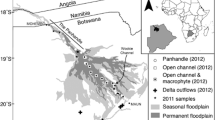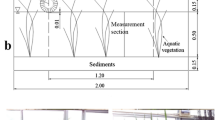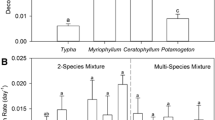Abstract
The potential importance of the six major emergent and floating-leaved macrophyte species in recycling of sediment phosphorus in the Loosdrecht lakes was studied. Representative plant samples were collected at the time of maximum biomass, and analysed for biomass and carbon, nitrogen and phosphorus contents. Species cover was determined by aerial photography.
Total cover in the seven lakes studied ranged between 2 and 26 percent. For the four main species, biomass per unit area increased with lake trophic status. Consistent differences in C, N and P contents per unit biomass were not observed. Although cover values were small, significant amounts of C, N and P were contained in the macrophytes when compared with maximum sestonic content.
Potential P loads from macrophyte decay were calculated. In Lake Loosdrecht, the P load represented 15 percent of current external P inputs. The potential importance of macrophyte decay to P recycling in the other lakes is greater.
Decay of macrophyte species at the end of the growing season appears to affect autumnal nutrient and chlorophyll a levels in the water column of some lakes. The re-establishment of submerged species following lake restoration may increase the importance of this pathway in the lakes.
Similar content being viewed by others
References
Anderson, F. O., 1978. Effects of nutrient level on decomposition of Phragmites communis Trin. Arch. Hydrobiol. 84: 42–54.
Barko, J. W. & R. M. Smart, 1980. Mobilization of sediment phosphorus by submersed freshwater macrophytes. Freshwat. Biol. 10: 229–238.
Best, E. P. H., 1982. The aquatic macrophytes of Lake Vechten. Species composition, spatial distribution and production. Hydrobiologia 95: 65–77.
Best, E. P. H., D. De Vries & A. Reins, 1984. The macrophytes in the Loosdrecht Lakes: a story of their decline in the course of eutrophication. Verh. int. Ver. Limnol. 22: 868–875.
Best, E. P. H., M. Zippin & J. H. A. Dassen, 1982. Studies on decomposition of Phragmites australis leaves under laboratory conditions. Hydrobiol. Bull. 16: 21–33.
Boers, P. C. M., 1986. Studying the phosphorus release from the Loosdrecht lakes sediments, using a continuous flow system. Hydrobiol. Bull. 20: 51–60.
Breebaart, L. & L. van Liere, 1986. Waterkwaliteitsonderzoek Loosdrechtse Plassen basisgegevens 1985. Internal Report, Limnological Institute, LI 1986-13, 113 pp.
Brock, Th. C. M., 1985. Ecological studies on Nymphaeid water plants with emphasis on production and decomposition. Ph.D thesis, Catholic University, Nijmegen. 204 pp.
Brock, Th. C. M., M. J. H. De Lyon, E. M. J. M. Van Laar & E. D. M. M. Van Loon, 1985. Field studies on the breakdown of Nuphar lutea (L.) Sm. (Nymphaeaceae) and a comparison of three mathematical models for organic weight loss. Aquat. Bot. 21: 1–22.
Carignan, R. & J. Kalff, 1980. Phosphorus sources for aquatic weeds: water or sediments? Science 207: 987–989.
Carpenter, S. R., 1980. Enrichment of Lake Wingra, Wisconsin, by submersed macrophyte decay. Ecology 61: 1145–1155.
Davis, C. D. & A. G. van der Valk, 1983. Uptake and release of nutrients by living and decomposing Typha glauca Godr. tissues at Eagle Lake, Iowa. Aquat. Bot. 16: 75–89.
Gons, H. J. & M. Rijkeboer, 1990. Algal growth and loss rates in Lake Loosdrecht: first evaluation of the roles of light and wind on a basis of steady state kinetics. Hydrobiologia 191: 129–138.
Kal, B. F. M., 1986. Monthly mass balances for compartments of the Loosdrecht lakes system: approach and preliminary results. Hydrobiol. Bull. 20: 27–39.
Kal, G. F. M., G. B. Engelen & Th. E. Cappenberg, 1984. Loosdrecht Lakes Restoration project: hydrology and physico-chemical characteristics of the lakes. Verh. int. Ver. Limnol. 22: 835–841.
Landers, D. H., 1982. Effects of naturally senescing aquatic macrophytes on nutrient chemistry and chlorophyll a of surrounding waters. Limnol. Oceanogr. 27: 428–439.
Mason, C. F. & R. J. Bryant, 1975. Production, nutrient content and decomposition of Phragmites communis Trin. and Typha angustifolia L. J. Ecol. 63: 71–95.
Meulemans, J. T. & P. J. Roos, 1987. Production and decomposition in the emergent littoral zone of Lake Maarsseveen. 1, an overview. Hydrobiol. Bull. 21: 61–69.
Moss, B., H. Balls, K. Irvine & J. Stansfield, 1986. Restoration of two lowland lakes by isolation from nutrient-rich water sources with and without removal of sediment. J. appl. Ecol. 23: 391–414.
Nichols, D. S. & D. R. Keeney, 1973. Nitrogen and phosphorus release from decaying water milfoil. Hydrobiologia 42: 509–525.
Polunin, N. V. C., 1984. The decomposition of emergent macrophytes in fresh water. Adv. ecol. Res. 14: 115–116.
Scholten, H. M., 1985. Water purification by aquatic macrophytes: a literature survey. Student report LI-1985–3, Limnological Institute, Nieuwersluis, The Netherlands.
Smith, C. S. & M. S. Adams, 1986. Phosphorus transfer from sediments by Myriophyllum spicatum. Limnol. Oceanogr. 31: 1312–1321.
Spangler, F. L., C. W. Fetter & W. E. Sloey, 1977. Phosphorus accumulation — discharge cycles in marshes. Wat. Res. Bull. 13: 1191–1201.
Timms, R. M. & B. Moss, 1984. Prevention of growth of potentially dense phytoplankton populations by zooplankton grazing, in the presence of zooplanktivorous fish, in a shallow wetland ecosystem. Limnol. Oceanogr. 29: 472–486.
Van Liere, L. & R. D. Gulati, 1990. Phosphorus dynamics following restoration measures in the Loosdrecht Lakes. Hydrobiologia 191: 87–95.
Van Liere, L., L. Van Ballegooijen, W. A. De Kloet, K. Siewertsen, P. Kouwenhoven & T. Aldenberg, 1986. Primary production in the various parts of the Loosdrecht lakes. Hydrobiol. Bull. 20: 77–85.
Author information
Authors and Affiliations
Rights and permissions
About this article
Cite this article
Malthus, T.J., Best, E.P.H. & Dekker, A.G. An assessment of the importance of emergent and floating-leaved macrophytes to trophic status in the Loosdrecht lakes (The Netherlands). Hydrobiologia 191, 257–263 (1990). https://doi.org/10.1007/BF00026060
Issue Date:
DOI: https://doi.org/10.1007/BF00026060




